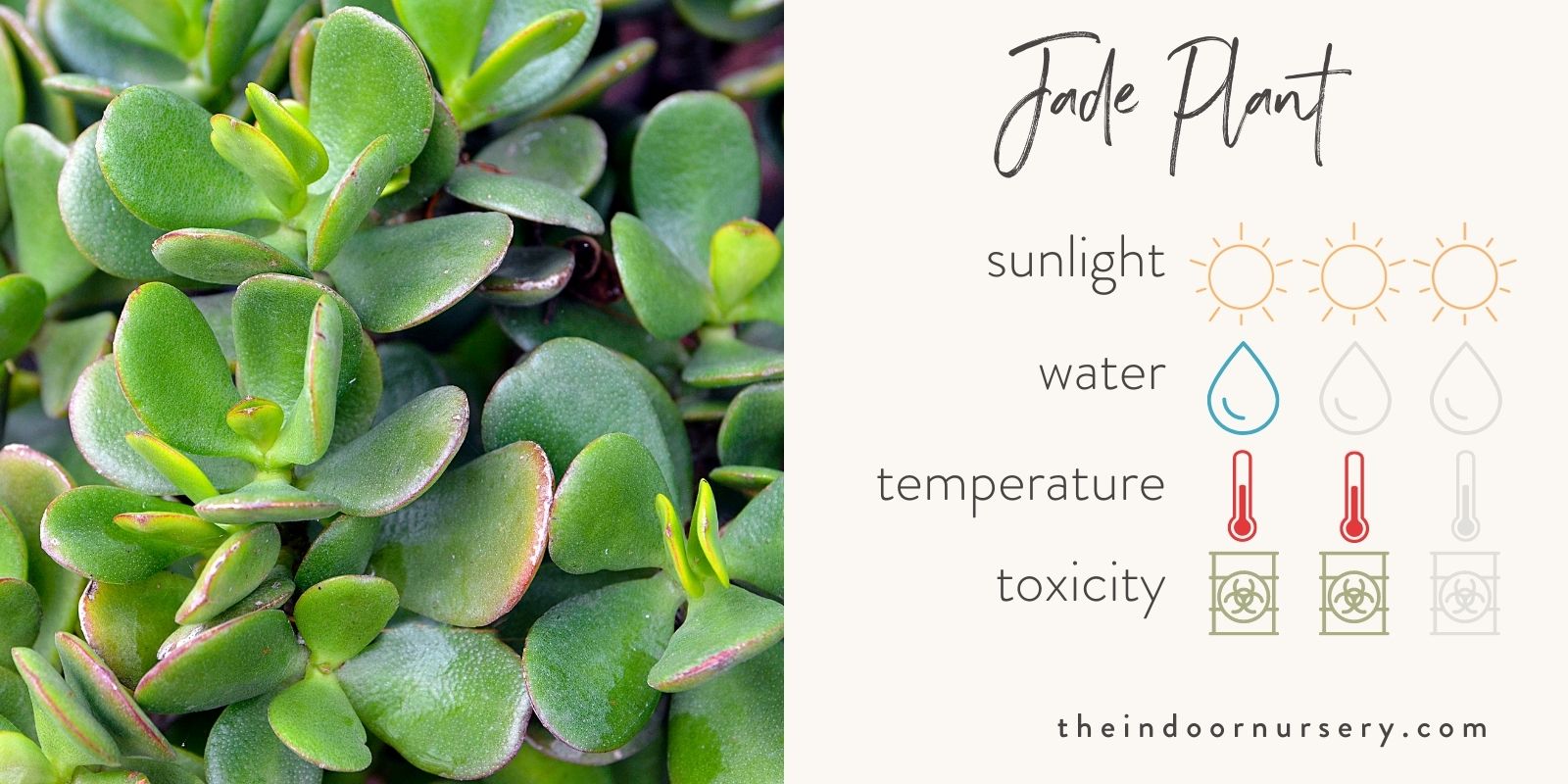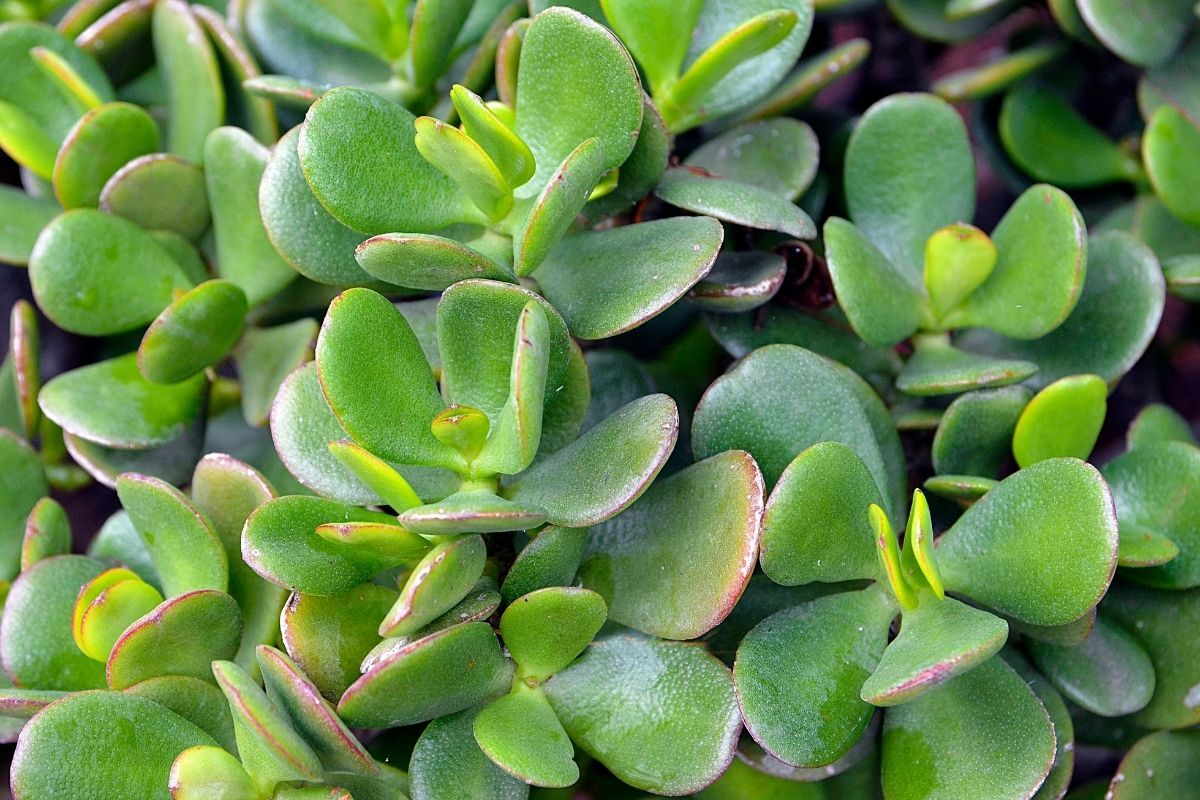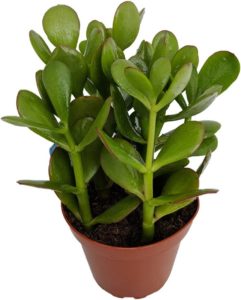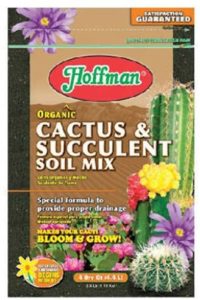plant description
T
his gem of a plant is one of THE most popular starter-kit succulents thanks to its no-fail propagation process and minimal watering needs. Over time, your jade plant will reward consistent care as it grows into a beautifully branched, ornamental table-piece that can live for generations.
The jade plant is so-named for its leaves’ resemblance to the precious jade stone. Jade’s scientific name, Crassula ovata, is Latin for “thick and egg-shaped,” referring to its fleshy, lobed leaves. Jade plants are loved for their branching, tree-like appearance – but make no mistake, this plant is a succulent through and through!
Jade plants originally developed their thick, woody stem to store moisture and protect from predators in the temperate grasslands and savannas of South Africa and Mozambique. These plants store water in their thick leaves as well as their dense, woody stems and branches, giving them a robust form and ability to withstand drought. Thanks to this remarkable biology, these succulents have notably low water requirements, even amongst succulents – and today live happily amongst apartment-dwellers and homeowners indoors.
If you’re lucky, your jade plant may produce a spray of pink or white flowers during the growing season once they mature. Despite the plant’s overall slow-growing nature, Jade is referenced as a symbol of renewal and luck, following its quick regeneration after pruning, easy propagation, and incredibly long lifespan. Jade plants can live for several decades with proper care.
plant facts
| common names | Jade, Lucky Plant, Money Tree |
| botanical name | Crassula ovata |
| no. of species | Na |
| family | Crassulaceae |
| biological life cycle | Perennial |
| foliage | Succulent |
| mature size | Up to 6 feet tall, up to 3 feet wide |
| time to maturity | Up to 3 years |
| origins | South Africa and Mozambique |
| light conditions | Full sun |
| soil type | Well-drained |
| water ph | Acidic to neutral (5.5-7) |
| usda zone | 11-12 |
| toxicity | Toxic to pets and humans |
Popular Varieties/Related Plants:
- Crosby’s Dwarf (Crassula Ovata ‘Crosby’s Dwarf’)
- Gollum, Monstruosa, ‘Cristata’ (Crassula Ovata ‘Gollum’)
- Cristata (Crassula Ovata ‘Cristata’)
- Tricolor, Lemon & Lime (Crassula Ovata ‘Lemon & Lime’)
- Undulata (Crassula undulata)
- Hummel’s Sunset (Crassula Ovata ‘Hummel’s Sunset’)

how to take care of a jade plant
Caring for a jade plant is similar to what you thought was a good flossing schedule before you got a cavity (LOL! seriously though) – the difference being that your jade plant will totally thrive with a twice monthly check-in! A happy jade plant truly only requires attention a couple of times a month as long as you don’t change its placement or fertilizer routine too quickly. These succulent stars are super drought tolerant and very happy with just a sip of water here and there during most times of the year. For this reason, it’s a good idea to bottom-water your jade plant. They like to sit in the sun and, as slow-growing plants, they mostly like to be left alone and looked at.
light 🔆
Best light: Bright direct and indirect sunlight
As a grassland native, Jade plants like a healthy dose of bright sunlight throughout the day. Mature plants can handle a day’s worth of direct sunlight, but younger plants will burn with a full day in the sun. Keep younger plants from 1-3 years old in indirect sunlight until you notice the color of the leaves darken slightly. With too little light, a jade plant will grow long, thin branches and stretch towards the nearest light source, potentially falling over from its top-heavy nature (plant pros call this getting “leggy”). It will also produce fewer leaves to conserve energy, due to the lack of light for photosynthesis. The more light, the more leaves you’ll see and the faster jade plants will grow.
water 💧
Water needs: Once every 1-4 weeks, depending on size and season
Jade plants are easy to take care of because they have low water requirements like other succulents. Their woody stems, however, can hold an extra amount of water, in addition to their thick leaves. Depending on the size of the plant, some Jade plants only need to be watered once every week or two, and even as little as once a month for big plants during the winter. Smaller plants are able to store less water than larger ones, and larger pots may make it more difficult for the plant to access all of the moisture.
The Jade plant has shallow roots, which help it in the wild in competition for scarce topsoil moisture with grasses, shrubs, and trees. Since the plant is naturally tolerant of drought, these roots like to be dry and in dry soil. It’s much easier to over-water a Jade than it is to under-water it.
humidity 🌫️
A Jade doesn’t have any special humidity requirements, and it’s happy in normal household air-moisture levels between 30 and 50%. Since this is a plant that likes to stay dry, keep it out of rooms that get a lot of air moisture or water splashed around. The jade plant’s impermeable leaves and stems won’t absorb excess moisture, which can result in mold or fungal growth.
temperature 🌡️
Although Jade plants grow in plains ecosystems with varying seasonal temperatures in the wild, they prefer a temperate atmosphere between 65 and 80 degrees indoors – which is right in the range of the average home temperature.
fertilizer 💩
Jade plants do best when fertilized once or twice a year during their growing season over spring and summer. In their native wild plains and grasslands, jade plants developed shallow root systems that acclimated them to an average topsoil profile of nutrients. In your home, these efficient growers will be happy with a light, yet consistent fertilization schedule.
soil 🪨
Soil Type: Well-drained
pH level: Acidic to neutral (5.5-7)
Topsoil is the first layer of soil to dry out in any ecosystem where the soil doesn’t stay consistently moist. Plants with shallow roots, like Jade plants, prefer well-draining soil without too much fluff. The best choice of growing medium for jade plants is either a 1:1 coarse material (orchid bark, sand, or Leca) to all purpose potting mix, or a pre-mixed soil for succulents and cactus. Jade plants are also good candidates to be grown in Leca since their roots like to be dry. Read more about how to grow plants in Leca here.
repotting 🪴
While slow-growing, jade plants can get pretty big as they mature. The size of the plant’s pot will have an effect on how large it grows, but it shouldn’t be potted in too large of a container in an effort to speed up the growing process (an oversized pot = weak roots for jade plants). To strike this balance, you’ll need to repot young jade plants once every 6 months – 1 year at first. Mature jade plants should be repotted once every few years until they reach the desired size. Check out our beginner’s guide to repotting succulents if you’re new to this!
propagation 🌱
You can propagate jade plants easily with stem or leaf cuttings. For leaf cuttings:
- Remove a single jade leaf from your mature jade plant
- Place the leaf on top of soil in a small new pot
- Spray the leaf and soil with mist every couple of days to encourage roots to sprout and grow into a new plant.
To propagate from stem cuttings:
- Cut a stem tip from your mature jade plant containing 3-4 leaves, leaving 1” of stem below the lowest leaf
- Prepare a small new pot with succulent soil and place the cutting ½” deep into it
- Mist regularly until roots develop, then slowly reduce watering
You can easily propagate trimmings from pruning your jade plant to a desired shape or size. Mature, healthy jade plants will quickly regrow new buds and shoots from the cut edge.
pruning 🌿
Whether or not you wish to propagate your jade plant, it’s important to prune jade plants as they age to keep them at a manageable size and encourage healthy foliage growth. When the branches of your jade plant get too big, light can’t reach the inner leaves and will result in die-back of those leaves in shadow. The plant can also get top-heavy, since It has dense woody branches with small, fibrous roots.
pests and diseases 🐛
The Jade plant’s shallow roots can be easily damaged by excess water. This makes them susceptible to root rot or fungal growth in the soil. Similarly, they can be damaged by soil pests like gnats, spider mites, and other common harmful houseplant insects.

plant care tips
- Jade plants make beautiful bonsai trees. Jade’s branching lobe formations and bendable stems have excellent sculpting potential, making them good candidates for bonsai. Bonsai, meaning tree in a small pot, is the art of pruning small, generally woody, potted plants in stylized shapes, be it a weeping fig, jade or pretty much any other branching plant. Through selective pruning, you can encourage your jade plant to grow into a unique form with good care and intentional maintenance. Since jade easily sprouts new buds and branches when it’s trimmed, Jade’s shape is more easily molded than other types of indoor plants.
- Check the leaf firmness for your jade’s watering needs. Jade leaves store water to last over periods of dryness. When leaves are well-hydrated, they will be firm, glossy, and, when squeezed gently, won’t have any give. If the plant is too dry, the leaves will become dull and waxy as a first sign of dehydration, and eventually begin to shrivel. The ideal time to water this plant is before they wrinkle, but when they have a slight give.

Common Problems / FAQs:
Why are my Jade’s leaves falling off?
If your Jade plant is losing leaves, chances are it’s being overwatered. Check the soil moisture and the condition of the roots; they might not be getting enough oxygen. If overwatering is the problem, let the soil dry out completely before watering again, then water sparingly going forward. Leaves may also fall off if the plant isn’t getting enough water, although they will begin to wilt before dropping. Finally, a Jade plant might lose its leaves if it isn’t getting enough light.
Why is my Jade plant growing to one side?
When Jade plants don’t get enough light, before the leaves wilt or fall off, the plant will reach its branches toward a source of light. Most plants do this, but a Jade has a heavier trunk and branches the bigger it gets. This reaching motion in one or another direction over a period of time may cause the plant to fall over from its top-heavy condition.
Shop our recommendations
- The Best Hydroponic Tower For Indoor Gardening
- 10 Best Worm Composter Bins For Easy Homemade Compost
- The Best pH Meter For Soil
- The 6 Best Dehumidifiers For Grow Tents
- The Best Complete Indoor Hydroponic Grow System
- 5 Best Grow Light Strips For Indoor Plants
- TESTED: Aerogarden vs Click and Grow Smart Garden
- Our *hands on* MARS HYDRO TSW 2000 review (with photos)
- 7 Best Hygrometers For Indoor Plants
- The Best Coco Coir For Your Plant’s Healthiest Root System Ever






Hey, Marcia! Thanks for reading :) gosh, that's a great idea to double up on your watering globe and spike.…